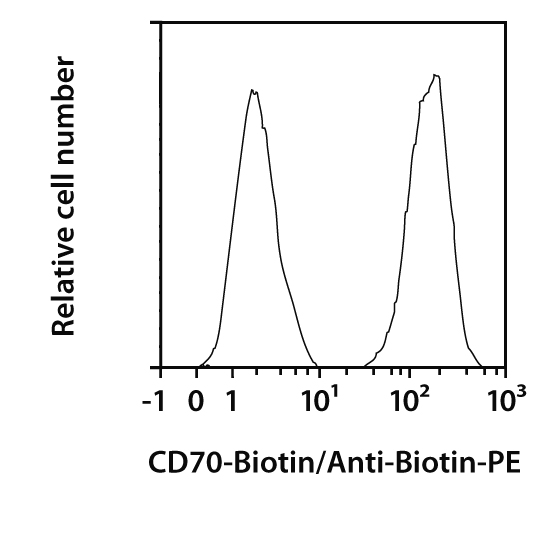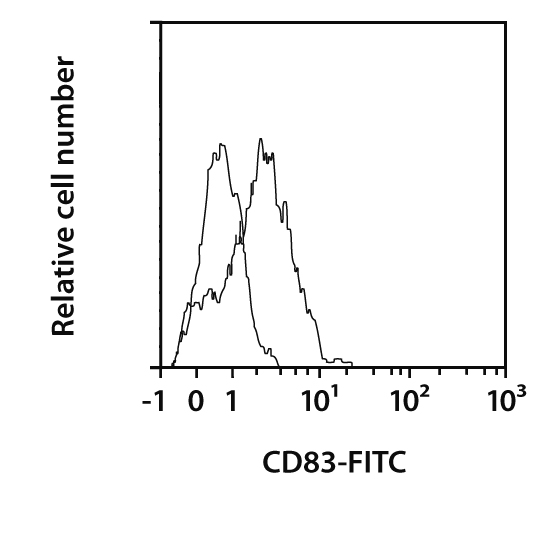Recombinant antibody
Code: 130-104-684
Overview
Clone REA280 recognizes the CD62 antigen-like family member E (CD62E) antigen, a 115 kDa single-pass type I membrane protein which is also known as E-selectin, endothelial-leukocyte adhesion molecule 1 (ELAM-1), or leukocyte-endothelial cell adhesion molecule 2 (LECAM2). CD62E is a cell adhesion molecule highly expressed only on endothelial cells activated by cytokines. It is not stored in the cell and has to be transcribed, translated, and transported to the cell surface. The production of CD62E is stimulated by the expression of CD62P which is stimulated by tumor necrosis factor α, and it can also be stimulated by interleukin-1 and lipopolysaccharide. CD62E recognizes and binds to sialylated carbohydrates present on the surface proteins of certain leukocytes. CD62E ligands are expressed by neutrophils, monocytes, eosinophils, memory-effector T-like lymphocytes, and natural killer cells. Each of these cell types is found in acute and chronic inflammatory sites in association with expression of CD62E, thus implicating CD62E in the recruitment of these cells to such inflammatory sites.
Additional information: Clone REA280 displays negligible binding to Fc receptors.
Alternative names
SELE, Elam, ESEL, LECAM2, ELAM-1, E-selectinSpecifications
- Human : 0
- PE : 0
- 30 tests : 0
- 0.3 ml : 0
- Recombinant Human IgG1 : 0
Code: 130-104-355
Overview
Clone REA292 recognizes the human CD70 antigen, a 50 kDa type II transmembrane glycoprotein also known as CD27 ligand (CD27L) or tumor necrosis factor ligand superfamily member 7 (TNFSF7). CD70 is a member of the TNF superfamily and is expressed by activated mouse T, B, and NK lymphocytes, activated plasmacytoid dendritic cells (pDCs), chronic B cell lymphocytic leukemia, and large B cell lymphomas. It interacts with CD27, its ligand on T cells, in order to promote T-B cell cross-stimulation and co-stimulates B cell proliferation and immunoglobulin production. It also plays a role in the pDC-induced B cell differentiation.
Additional information: Clone REA292 displays negligible binding to Fc receptors.
Alternative names
CD27L, CD27LG, TNFSF7Specifications
- Human : 0
- Biotin : 0
- 30 tests : 0
- 0.3 ml : 0
- Recombinant Human IgG1 : 0
Code: 130-104-356
Overview
Clone REA292 recognizes the human CD70 antigen, a 50 kDa type II transmembrane glycoprotein also known as CD27 ligand (CD27L) or tumor necrosis factor ligand superfamily member 7 (TNFSF7). CD70 is a member of the TNF superfamily and is expressed by activated mouse T, B, and NK lymphocytes, activated plasmacytoid dendritic cells (pDCs), chronic B cell lymphocytic leukemia, and large B cell lymphomas. It interacts with CD27, its ligand on T cells, in order to promote T-B cell cross-stimulation and co-stimulates B cell proliferation and immunoglobulin production. It also plays a role in the pDC-induced B cell differentiation.
Additional information: Clone REA292 displays negligible binding to Fc receptors.
Alternative names
CD27L, CD27LG, TNFSF7Specifications
- Human : 0
- FITC : 0
- 30 tests : 0
- 0.3 ml : 0
- Recombinant Human IgG1 : 0
Code: 130-104-472
Overview
Clone REA304 recognizes the mouse CD83 antigen, a Single-pass type I membrane protein which belongs to the immunoglobulin superfamily. Murine CD83 is moderately expressed on resting T cells and DC, but strongly increases in its expression on T cells following activation with antigenic peptides or T cell receptor-specific monoclonal antibody. When returning to the resting state, T cells down-regulate CD83 again. Histological analysis of serial spleen sections revealed a CD83 expression pattern resembling that of MIDC-8, a known murine DC marker molecule.
Additional information: Clone REA304 displays negligible binding to Fc receptors.
Alternative names
B-cell activation protein, Cell surface protein HB15Specifications
- Biotin : 0
- Mouse : 0
- 200 tests : 0
- 30 µg in 1 mL : 0
- Recombinant Human IgG1 : 0
Code: 130-104-521
Overview
Clone REA304 recognizes the mouse CD83 antigen, a Single-pass type I membrane protein which belongs to the immunoglobulin superfamily. Murine CD83 is moderately expressed on resting T cells and DC, but strongly increases in its expression on T cells following activation with antigenic peptides or T cell receptor-specific monoclonal antibody. When returning to the resting state, T cells down-regulate CD83 again. Histological analysis of serial spleen sections revealed a CD83 expression pattern resembling that of MIDC-8, a known murine DC marker molecule.
Additional information: Clone REA304 displays negligible binding to Fc receptors.
Alternative names
B-cell activation protein, Cell surface protein HB15Specifications
- Biotin : 0
- Mouse : 0
- 60 tests : 0
- 9 µg in 300 µL : 0
Code: 130-104-473
Overview
Clone REA304 recognizes the mouse CD83 antigen, a Single-pass type I membrane protein which belongs to the immunoglobulin superfamily. Murine CD83 is moderately expressed on resting T cells and DC, but strongly increases in its expression on T cells following activation with antigenic peptides or T cell receptor-specific monoclonal antibody. When returning to the resting state, T cells down-regulate CD83 again. Histological analysis of serial spleen sections revealed a CD83 expression pattern resembling that of MIDC-8, a known murine DC marker molecule.
Additional information: Clone REA304 displays negligible binding to Fc receptors.
Alternative names
B-cell activation protein, Cell surface protein HB15Specifications
- FITC : 0
- Mouse : 0
- 200 tests : 0
- 30 µg in 1 mL : 0
- Recombinant Human IgG1 : 0
Code: 130-104-522
Overview
Clone REA304 recognizes the mouse CD83 antigen, a Single-pass type I membrane protein which belongs to the immunoglobulin superfamily. Murine CD83 is moderately expressed on resting T cells and DC, but strongly increases in its expression on T cells following activation with antigenic peptides or T cell receptor-specific monoclonal antibody. When returning to the resting state, T cells down-regulate CD83 again. Histological analysis of serial spleen sections revealed a CD83 expression pattern resembling that of MIDC-8, a known murine DC marker molecule.
Additional information: Clone REA304 displays negligible binding to Fc receptors.
Alternative names
B-cell activation protein, Cell surface protein HB15Specifications
- FITC : 0
- Mouse : 0
- 60 tests : 0
- 9 µg in 300 µL : 0
- Recombinant Human IgG1 : 0
Code: 130-104-474
Overview
Clone REA304 recognizes the mouse CD83 antigen, a Single-pass type I membrane protein which belongs to the immunoglobulin superfamily. Murine CD83 is moderately expressed on resting T cells and DC, but strongly increases in its expression on T cells following activation with antigenic peptides or T cell receptor-specific monoclonal antibody. When returning to the resting state, T cells down-regulate CD83 again. Histological analysis of serial spleen sections revealed a CD83 expression pattern resembling that of MIDC-8, a known murine DC marker molecule.
Additional information: Clone REA304 displays negligible binding to Fc receptors.
Alternative names
B-cell activation protein, Cell surface protein HB15Specifications
- PE : 0
- Mouse : 0
- 200 tests : 0
- 30 µg in 1 mL : 0
- Recombinant Human IgG1 : 0












